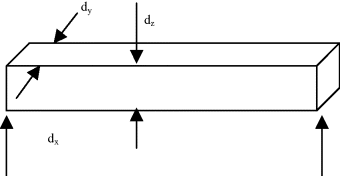3.3 Quantum Wires and Dots
In Section 3.2, we have seen that confinement of electrons or holes in a narrow 1D potential well, along the z-direction, say, leads to 2D electron and hole gas. The structure is called a QW. In this section, we shall consider the effect of introducing further confinement to the motion of electrons and study the relevant subband structures and a few electronic properties briefly. The simple theory with infinite potential barriers will be presented.
3.3.1 Subbands and DOS in Quantum Wires
Assume first that the confinement is extended into two dimensions, that is, along the y and z directions. Extending the earlier arguments, the electron motion is now confined in two directions, y and z; the only direction the electrons are free to move along is the x-direction. We now encounter a one-dimensional electron gas (1 DEG). Because of the nature of the potential, the structure supporting 1D electrons (or holes) is called the quantum wire (QWR) structure. A schematic diagram of the structure is shown in Figure 3.7.
Figure 3.7 Schematic structure of QWR.

Following the arguments given in Section 2.3, the envelope function for electrons in a 2D confining potential V(y,z) along y and z should satisfy the effective mass equation
(3.26) ![]()
The effective mass has been assumed ...
Get Silicon Photonics: Fundamentals and Devices now with the O’Reilly learning platform.
O’Reilly members experience books, live events, courses curated by job role, and more from O’Reilly and nearly 200 top publishers.

